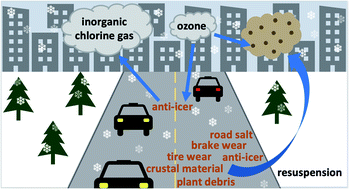Emerging investigator series: ozone uptake by urban road dust and first evidence for chlorine activation during ozone uptake by agro-based anti-icer: implications for wintertime air quality in high-latitude urban environments†
Abstract
High-latitude urban regions provide a unique and complex range of environmental surfaces for uptake of trace pollutant gases, including winter road maintenance materials (e.g., gravel, rock salts, and anti-icer, a saline solution applied to roads during winter). In an effort to reduce the negative environmental and economic impacts of road salts, many municipalities have turned to agro-based anti-icing materials that are rich in organic material. To date, the reactivity of both anti-icer and saline road dust with pollutant gases remain unexplored, which limits our ability to assess the potential impacts of these materials on air quality in high-latitude regions. Here, we used a coated-wall flow tube to investigate the uptake of ozone, an important air pollutant, by road dust collected in Edmonton, Canada. At 25% relative humidity (RH) and 50 ppb ozone, γBET for ozone uptake by this sample is (8.0 ± 0.7) × 10−8 under dark conditions and (2.1 ± 0.1) × 10−7 under illuminated conditions. These values are 2–4× higher than those previously obtained by our group for natural mineral dusts, but are not large enough for suspended road dust to influence local ozone mixing ratios. In a separate set of experiments, we also investigated the uptake of ozone by calcium chloride (i.e., road salt) and commercial anti-icer solution. Although ozone uptake by pure calcium chloride was negligible, ozone uptake by anti-icer was significant, which implies that the reactivity of anti-icer is conferred by its organic content. Importantly, ozone uptake by anti-icer—and, to a lesser extent, road dust doped with anti-icer—leads to the release of inorganic chlorine gas, which we collected using inline reductive trapping and quantified using ion chromatography. To explain these results, we propose a novel pathway for chlorine activation: here, ozone oxidation of the anti-icer organic fraction (in this case, molasses) yields reactive OH radicals that can oxidize chloride. In summary, this study demonstrates the ability of road dust and anti-icer to influence atmospheric oxidant mixing ratios in cold-climate urban areas, and highlights previously unidentified air quality impacts of winter road maintenance decisions.

- This article is part of the themed collections: Atmospheric chemistry and Emerging Investigator Series


 Please wait while we load your content...
Please wait while we load your content...